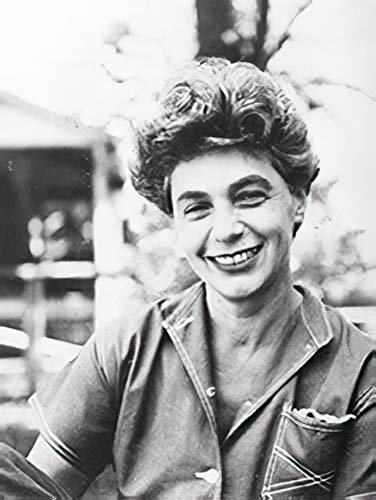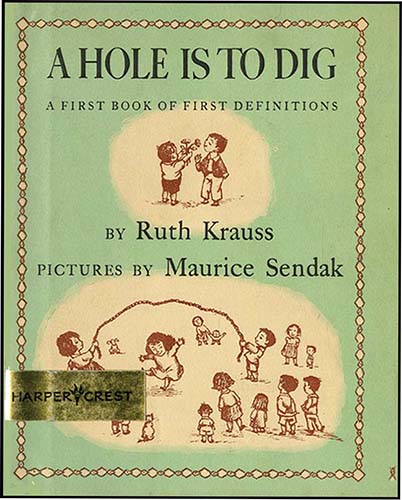Share via:
Ruth Ida Krauss – American Poet and Author 1901-1993

Inspired by the experimental atmosphere in child development circles during the 1940s and 1950s, Ruth Krauss created simple stories and poetry for young children. Best known for her classic picture book, The Carrot Seed (1944), illustrated by her husband, Crockett Johnson, Ruth Krauss went on to publish more than thirty books over the next four decades. Among them were eight picture book collaborations with illustrator Maurice Sendak. Their fortuitous be ginning resulted in the publication of A Hole is to Dig: A First Book of First Definitions (1951), the small innovative picture book that established Sendak as a formidable figure in children’s book illustration.
During the early 1940s, Ruth Krauss was a member of the experimental Writers Laboratory at the Bank Street School in New York City, a program that fostered the talents of other great picture book writers, such as Margaret Wise Brown. Ruth Krauss incorporated the “here and now” philosophy originated by educator and author Lucy Sprague Mitchell, founder of the Bank Street School, who maintained that “young children live in the ’here and now’ world around them, which they use as a laboratory for their explorations.” Krauss furthered Mitchell’s ideas by incorporating psychologist-pediatrician Arnold Gesell’s theories on the acquisition of language to create her own playful perspective on a young child’s reality. She adopted Mitchell’s concept of “direct observation” and went to the children themselves to glean her text for A Hole Is to Dig. She queried the young students to determine their meanings for words and in doing so created one of the first concept books for young children. Definitions like “Dogs are to kiss people” or “A lap is so you don’t get crumbs on the floor” reflect a child’s pragmatic approach to language.

In her books Ruth Krauss often used a child’s natural word forms and expressions, most notably in A Very Special House, the Caldecott Honor Book in 1954, in which the young narrator pontificates in an unselfconscious, child-centered stream of thought. Krauss’s imaginative and humorous use of language in the form of invented words and nonsensical rhymes inspired the first books for young children reflecting the child’s inner life, Widely acclaimed as “the little book with the big idea,” The Carrot Seed, which masterfully builds tension by using repetition in its short, 101-word text, has remained in print since 1945.
Unflappable and confident, a little boy weeds and waters his precious carrot seed even though bis parents and brother believe “it won’t come up.” With the simplest word and, Krauss paces the story while Johnson intensifies the climax by introducing bold color and oversize scale to picture the boy’s huge red carrot topped with bushy green fronds — a carrot so big the boy needs a wheelbarrow to hold it. In The Happy Day, selected as a Caldecott Honor Book in 1950, Ruth Krauss’s word patterns create rhythm in the simple text. Following a linear progression, several woodland animals sleep, sniff, and run to discover a bright yellow flower growing in the snow. Repetition and rhythm allow Krauss to seamlessly introduce five different species to the youngest listeners and readers.
Ruth Krauss’s intuitive ability as a writer to capture the free-spirited thought processes and language of young children ensures her books’ widespread acceptance and timeless appeal.
S.M.G.
Source: Children’s Books and their Creators, Anita Silvey.
Ruth Krauss Bibliography
Children’s Books
- A Good Man and His Good Wife, illustrated by Ad Reinhardt (1944)
- The Carrot Seed, illus. Crockett Johnson (1945)
- The Great Duffy, illus. Mischa Richter (1946)
- The Growing Story, illus. Phyllis Rowand (1947)
- Bears, illus. Rowand (1948); re-illus. Maurice Sendak (2005)
- The Happy Day, illus. Marc Simont (1949)
- The Big World and the Little House, illus. Simont (1949).
- The Backward Day, illus. Simont (1950)
- I Can Fly, illus. Mary Blair (1950)
- The Bundle Book, illus. Helen Stone (1951)
- A Hole is to Dig: A First Book of First Definitions, illus. Sendak (1952)
- A Very Special House, illus. Maurice Sendak (1953)
- I’ll Be You and You Be Me, illus. Maurice Sendak (1954)
- How To Make An Earthquake, illus. Johnson (1954)
- Charlotte and the White Horse, illus. Maurice Sendak (1955)
- Is This You?, by Krauss and Johnson (1955)
- I Want to Paint My Bathroom Blue, illus. Maurice Sendak (1956)
- Monkey Day, illus. Phyllis Rowand (1957)
- The Birthday Party, illus. Maurice Sendak (1957)
- Somebody Else’s Nut Tree, and Other Tales from Children, illus. Maurice Sendak (1958)
- A Moon or a Button: A Collection of First Picture Ideas, illus. Remy Charlip (1959)
- Open House for Butterflies, illus. Maurice Sendak (1960)
- Mama, I Wish I Was Snow; Child You’d Be Very Cold, illus. Ellen Raskin (1962)
- A Bouquet of Littles, illus. Jane Flora (1963
- Eyes, Nose, Fingers, Toes, illus. Elizabeth Schneider (1964)
- What a Fine Day for …, illus. Remy Charlip (1967)
- The Happy Egg, illus. Johnson (1967)
- This Thumbprint: Words and Thumbprints (1967)
- The Little King, the Little Queen, the Little Monster and Other Stories You Can Make Up Yourself (1968)
- If Only (1969)
- I Write It, illus. Mary Chalmers (1970)
- Under Twenty (1970)
- Everything Under a Mushroom, illus. Margot Tomes (1973)
- Love and the Invention of Punctuation (1973)
- Little Boat Lighter Than a Cork, illus. Esther Gilman (1976)
- Under Thirteen (1976)
- When I Walk I Change the Earth (1978)
- Somebody Spilled the Sky, illus. Eleanor Hazard (1979)
- Minnestrone (1981)
- Re-examination of Freedom (1981)
- Love Poems for Children (1986)
- Big and Little, illus. Mary Szilagyi (1987)
- And I Love You, illus. Steven Kellogg (1987)
Poetry and verse plays
- There’s A Little Ambiguity Among the Bluebells and Other Theater Poems (1968)
- The Cantilever Rainbow, illus. Antonio Frasconi (1965)
- This Breast Gothic (1973)
